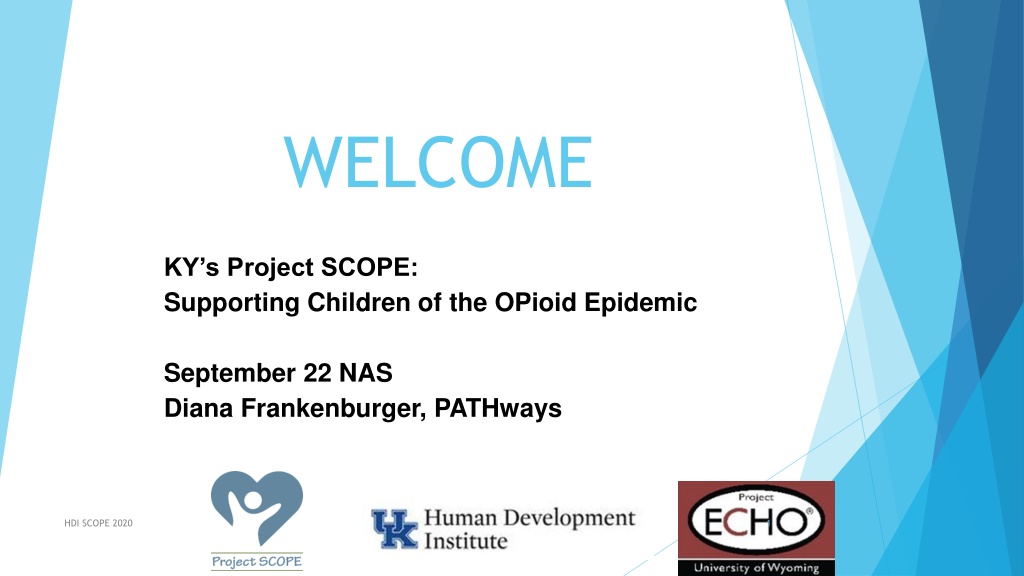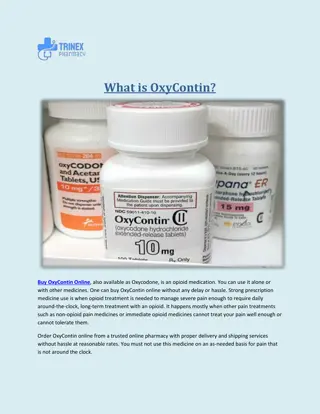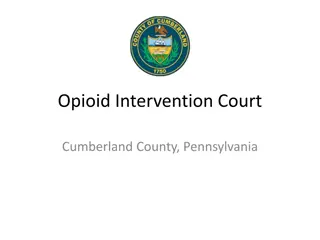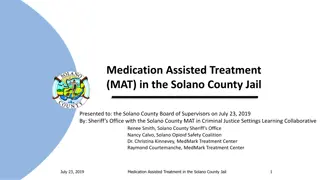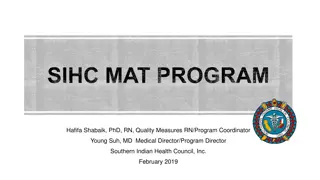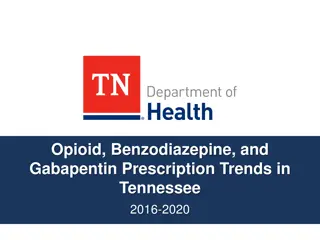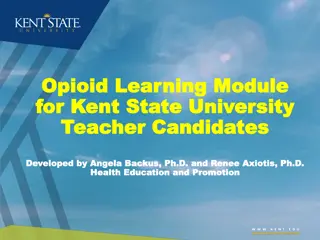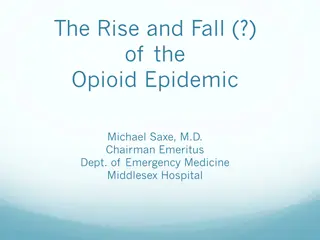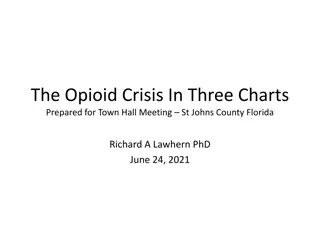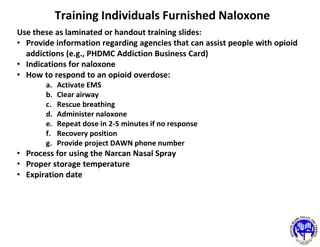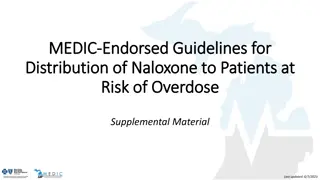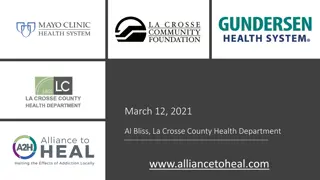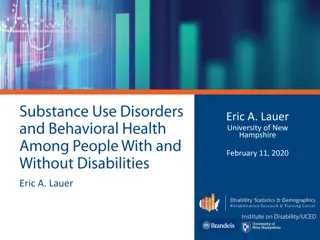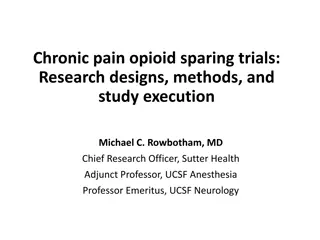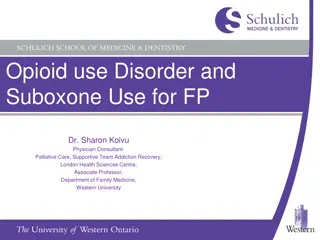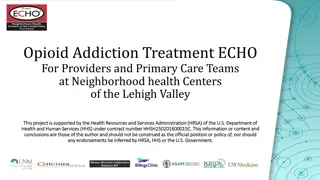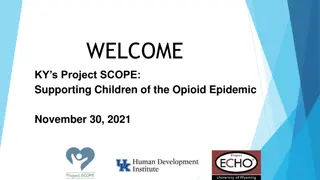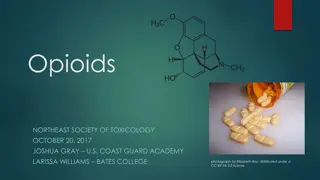Supporting Children of the Opioid Epidemic Series
Today's agenda includes discussions on various topics related to supporting children affected by the opioid epidemic, featuring speakers like Diana Frankenburger. Facilitators from different regions will lead breakout sessions and group discussions. Participants are encouraged to engage with new resources and submit case studies for further exploration.
Download Presentation

Please find below an Image/Link to download the presentation.
The content on the website is provided AS IS for your information and personal use only. It may not be sold, licensed, or shared on other websites without obtaining consent from the author.If you encounter any issues during the download, it is possible that the publisher has removed the file from their server.
You are allowed to download the files provided on this website for personal or commercial use, subject to the condition that they are used lawfully. All files are the property of their respective owners.
The content on the website is provided AS IS for your information and personal use only. It may not be sold, licensed, or shared on other websites without obtaining consent from the author.
E N D
Presentation Transcript
WELCOME KY s Project SCOPE: Supporting Children of the OPioid Epidemic September 22 NAS Diana Frankenburger, PATHways HDI SCOPE 2020 1
Note Selected Topics for this Series Tuesday, September 22 (NAS, Diana Frankenburger) Tuesday, October 6 (Monitoring Child Development, Dr. Jennifer Grisham) Tuesday, October 20 (Having Difficult Conversations, Jason Joy) Tuesday, October 27 (Trauma-Informed Interventions for Families with Young Children, Miriam Silman) Tuesday, November 17 (The Role of Peers for Families in Recovery, Sharon Hesseltine and Kim Hillard) TIMES: 2PM 3:30 PM EASTERN TIME EACH DATE 2
Today's Agenda (modified per feedback) 2:00-2:05 pm Procedures 2:05-2:40 pm NAS (Diana Frankenburger, PATHways) 2:40-2:45 pm Case Presentation (Denise Jaeger, Wendy Kluender) 2:45-3:10 pm Breakout sessions; select new spokesperson 3:10-3:28 pm Reconvene large group; discussion 3:28-3:30 pm Session closure 3
Facilitators and Regions Group 1: Karen Cottengim (Northkey) with Marie Vice (PATHways); N KY Group 2: Christine Hausman (HDI) with Suzanne Ross (CCA); E KY Group 3: Canyon Hardesty, SCOPE; WY Inst for Disabilities Dir of Community Ed and Training, U of Utah faculty; Joy Varney (KPFC); Louisville area Group 4: Kate Dean (CCA) with Bethany Wilson (PATHways); with Stephanie Weber, SCOPE; Training Director, Cincinnati Univ Cent of Excellence in Devel Dis, Clinical Psychologist Group 5: Tonya Jernigan (Dept of Pediatrics) withJessica White (Chrysalis House); Central KY Group 6: Emily Moseley (HDI) with Barb Greene (KPFC); E KY Group 7: Caroline Gooden (HDI) with Amanda Metcalf (KPFC); W KY 4
Session Updates First name, last name, agency in zoom profile and chat Take care of your needs Thank you for protecting confidentiality Session recorded and close captioned Thank you and please continue to submit Case Studies; See Case Study folder in resource site for forms See new resources: Resource folder https://www.hdilearning.org/project-scope-echo-series/ 5
Resource Materials and Zoom All session materials available at https://www.hdilearning.org/project-scope-echo-series/ Case Study submission and Facilitator Notes forms: Case Study folder, resource site Please contact brandon.cannada@uky.edu if you need assistance with technology Rejoin zoom anytime bounced off at https://uky.zoom.us/j/95713159978 Please be patient as Brandon reassigns you to groups 6
Neonatal Abstinence Syndrome (NAS) Diana Frankenburger, PATHways 7
Team KY SCOPE Case Study Presentation Denise Jaeger, OTR/L; Wendy Kluender, PT First Steps 8
Background on Case Lucas was born after being exposed to many substances in utero (fentanyl heroin, meth, THC, tobacco, Vicodin, Xanax, and Adderall) Birth father also polysubstance abuser, died shortly after Lucas birth Lucas spent 2 weeks in NICU, in a study and getting no treatment initially. After 2 weeks, no treatment discontinued; methadone treatment initiated. When discharged home, he was sleeping 15 minutes at time and extremely sensitive to any sensory input. Original diagnosis in early intervention was NAS and torticollis. Once home with adoptive parents, he had tremors for about a month and excessive startle reflex. Parents were told that because of exposure to substances, he should have increased sensory inputs rather than limiting inputs to slowly help him accommodate. That approach was not effective and we could find no research to support that intervention. Currently 19 months old 9
Primary Area of Concern Falls frequently and doesn t seem to see obstacles in path Seeks significant amount of proprioceptive input through pushing furniture, hitting, throwing, rocking. Will not pull objects, only push Formerly biting and pulling hair Expressive language delayed- uses a few signs, shakes head yes/no, points and can follow simple directions. No words so far. Is < 1st percentile for height, <60% for weight (genetics work-up underway) Ophthalmologist saw no concerns but mom is not convinced. 10
Goals, Barriers, Strengths Goals: Age appropriate speech Effectively meet sensory needs throughout the day Walk without falling Barriers: Sensory needs difficult to determine and meet Not sure how vision, vestibular, and motor skills affect his balance Does poorly in visually busy environment Strengths: Great family support and compliance 3 year old adoptive brother also had NAS, has made good progress 11
Additional Information We have tried: Compression vest Weighted ball, bean bags Brushing, infant massage, joint compressions Balance activities, proprioceptive strategies such as rocking, swinging, getting pulled on blanket Mom has decreased visual clutter Recently discovered: being in small enclosed space helps him calm 12
Additional Information During follow-up, infants with NAS particularly require (1) neurodevelopmental assessments to identify motor deficits, cognitive delays, or relative microcephaly; (2) psycho-behavioral assessments to identify hyperactivity, impulsivity, and attention-deficit in preschool-aged children, as well as school absence, school failure, and other behavioral problems in school aged children; (3) ophthalmologic assessment to identify nystagmus, strabismus, refractive errors, and other visual defects; (4) growth and nutritional assessment to identify failure to thrive and short stature; and (5) family support assessments to exclude continuous maternal substance abuse and child abuse (Kocherlakota, 2014). Kocherlakota, P. (2014). Neonatal Abstinence Syndrome, Pediatrics, 134(2): p.e-547-e-561. doi:10.1542/peds.2013-3524 Failure to use eye movements to predict another person s actions may have negative developmental consequences as a child may have difficulty imitating and learning from others thus affecting social cognition. (NAS PowerPoint from Cincinnati) Konijnenberg, C et al. (2012). A Melinder, Neurodevelopmental Investigation of the Mirror Neuron System in Children of Women receiving Maintenance Therapy during Pregnancy, Addiction Res Report. 13
Breakout Discussion What are some family/child strengths? What are some strategies suggested by your group? Do you have any resources, websites, or documents to share with Project SCOPE colleagues? Other comments/questions/suggestions? 14
Evaluation Pre-series survey; evaluations after each session and after series Incentives: drawing after each session; book selection for participants who attend all sessions; certificate of attendance for sessions attended 15
Questions? Contact us with any questions: Content and case presentations: caroline.gooden@uky.edu; christine.hausman@uky.edu Technology: brandon.cannada@uky.edu Evaluation and case presentations: emily.moseley@uky.edu See you next session, Oct 6 at 2pm Monitoring Child Development Dr. Jennifer Grisham, UK Early Childhood 16
